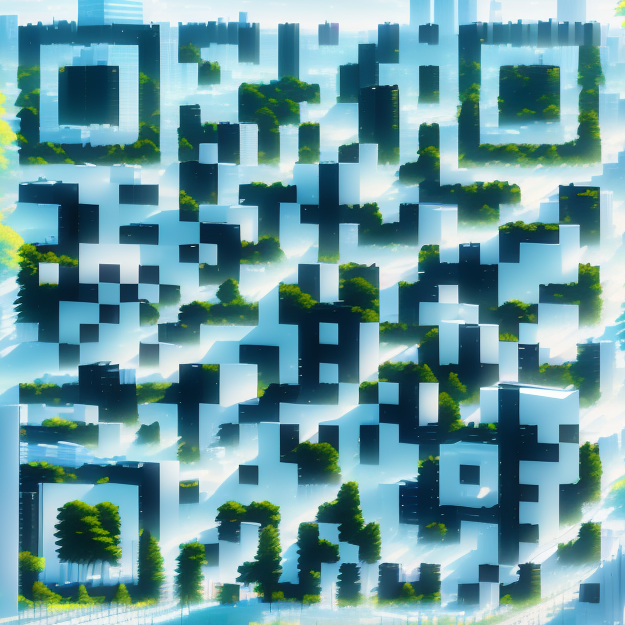精神
Ethos
“TARANG”展亭的设计旨在以一种超越当下的连续性和连接感,营造出一个永恒的环境,促进不同时代之间的对话。在设计时,建筑师将印度西南地区的特殊环境纳入考虑之中,并采用了非凡的建筑技术,展示出一种创新且深思熟虑设计方法,以应对建筑领域在可持续性方面面临的紧迫挑战,同时以其环境的友好性,文化的丰富性,与迷人的视觉性为人们带来丰富的空间体验。该项目没有采用任何软件或数字工具,而是完全依靠传统的建筑技术,可谓是对当地建造技术与手工工艺的致敬。
“TARANG” fosters a timeless environment, promotinga meaningful dialogue between different eras. Its design evokes a sense of continuity and connection that transcends the present moment, encouraging a dialogue that spans across time. Tarang’s design takes into account the specific context of the South West location and incorporates a remarkable construction technique. The design showcases an innovative and thoughtful approach to address the pressing challenge of sustainable construction, creating a built environment that is environmentally friendly, culturally rich, and visually captivating. By employing traditional construction techniques without software or digital tools, Tarang celebrates the artistry of the workers.
▼项目概览,overall of the project© Photographix India
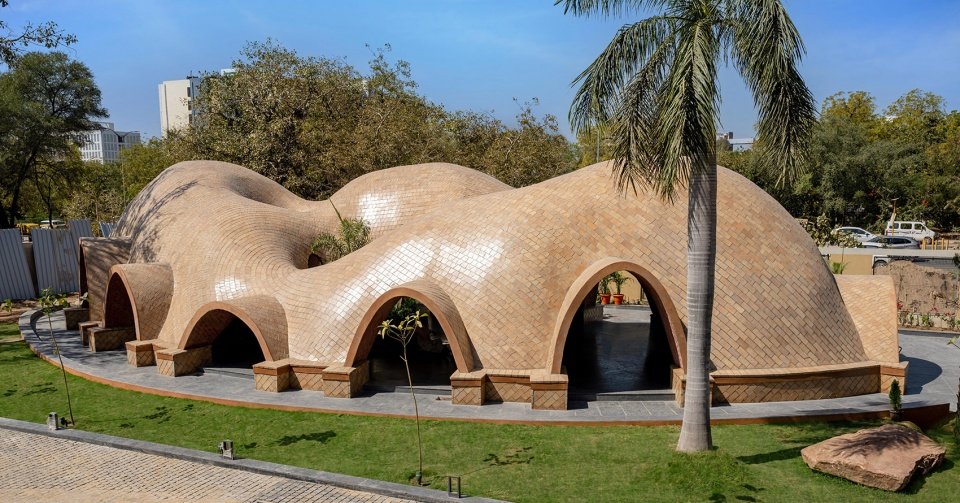
意图
Intent
项目的目的是创造出一个多功能的空间,以满足建筑内部和周围的各种活动需求。建筑师将TARANG构想为一处动态化的画廊空间,以精心的设计去营造一系列流畅连续的空间体验。其目的是作为一个沉浸式的展览平台,在这里,建筑内部空间被转化为画布,用于展示当地的特色产品。
The intervention aims to create a versatile space that accommodates various activities, both within and around the building.Tarang was conceptualized as a dynamic gallery space, meticulously designed to adapt and evolve seamlessly. Its purpose is to serve as an immersive exhibition platform where the interiors are transformed into canvases, showcasing the featured products.
▼有机的几何形态,organic geometry© Vinay Panjwani /Photographix India

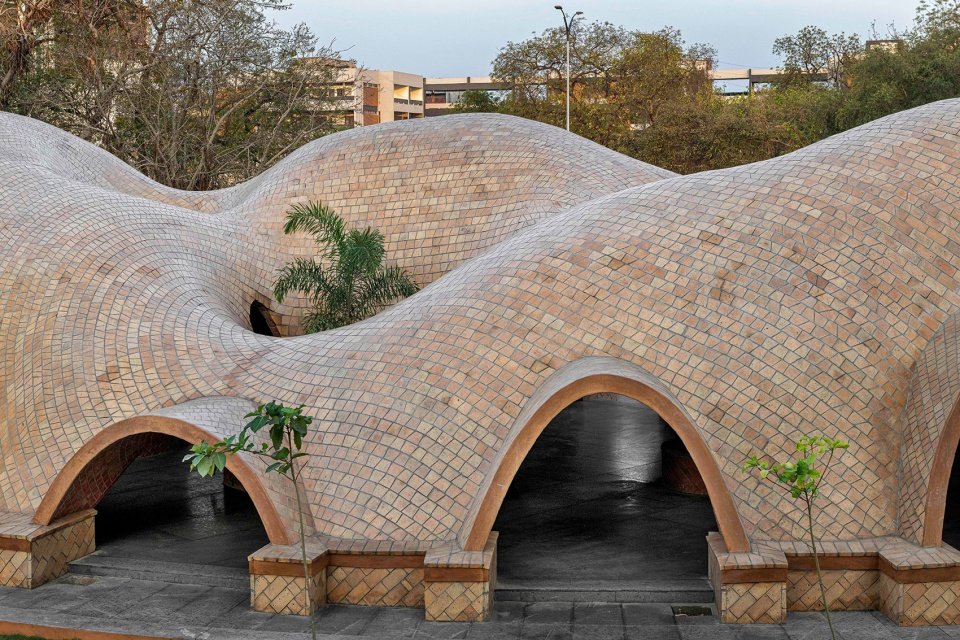
▼顶视图,top view© Vinay Panjwani

环境可持续性
Environmental sustainability effort
为了尽量减少建筑的碳足迹,该项目主要采用了当地材料,尤其以低能耗的材料为主。其中最关键的材料为天然石材与陶瓦。大跨度的展亭没有采用任何钢结构,也没有辅以任何典型拱形建筑中所采用的附属结构。此外,本项目十分注重泥瓦匠的技能提升,以进一步促进可持续建筑实践的发展。
In an effort to minimize the carbon footprintof buildings, the project primarily sources materials locally, with a focus on those that have low embodied energy. The key materials utilized include natural stone, terracotta tiles, and a technique that involves spanning without steel and shuttering or ancillary structures that are typically used to bear the weight of an arch during the building process. Additionally, the project places emphasis on upskilling the masons to further promote sustainable building practices.
▼展亭外观,exterior view of the pavilion© Photographix India
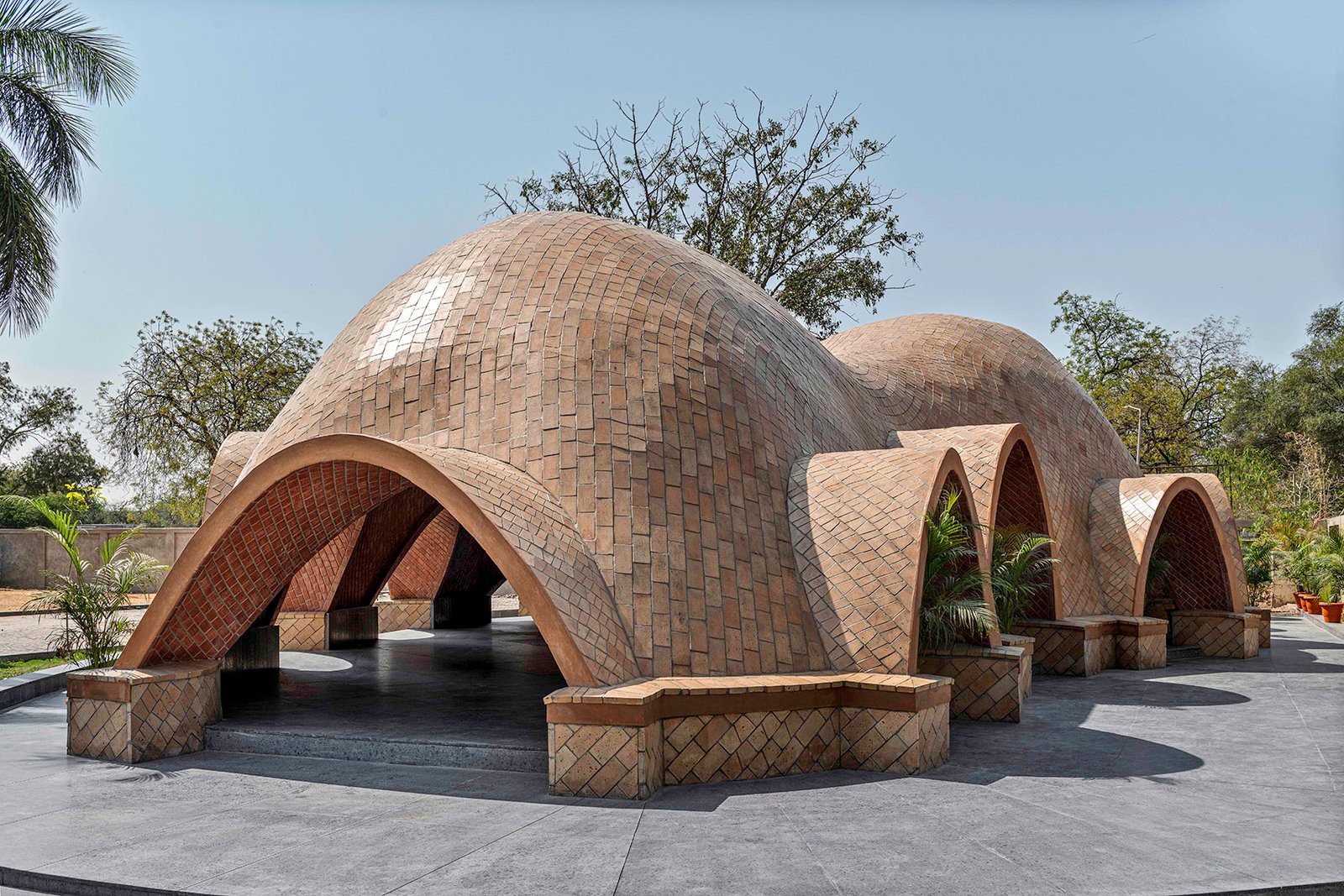
▼屋顶细部,details of the roof© Photographix India

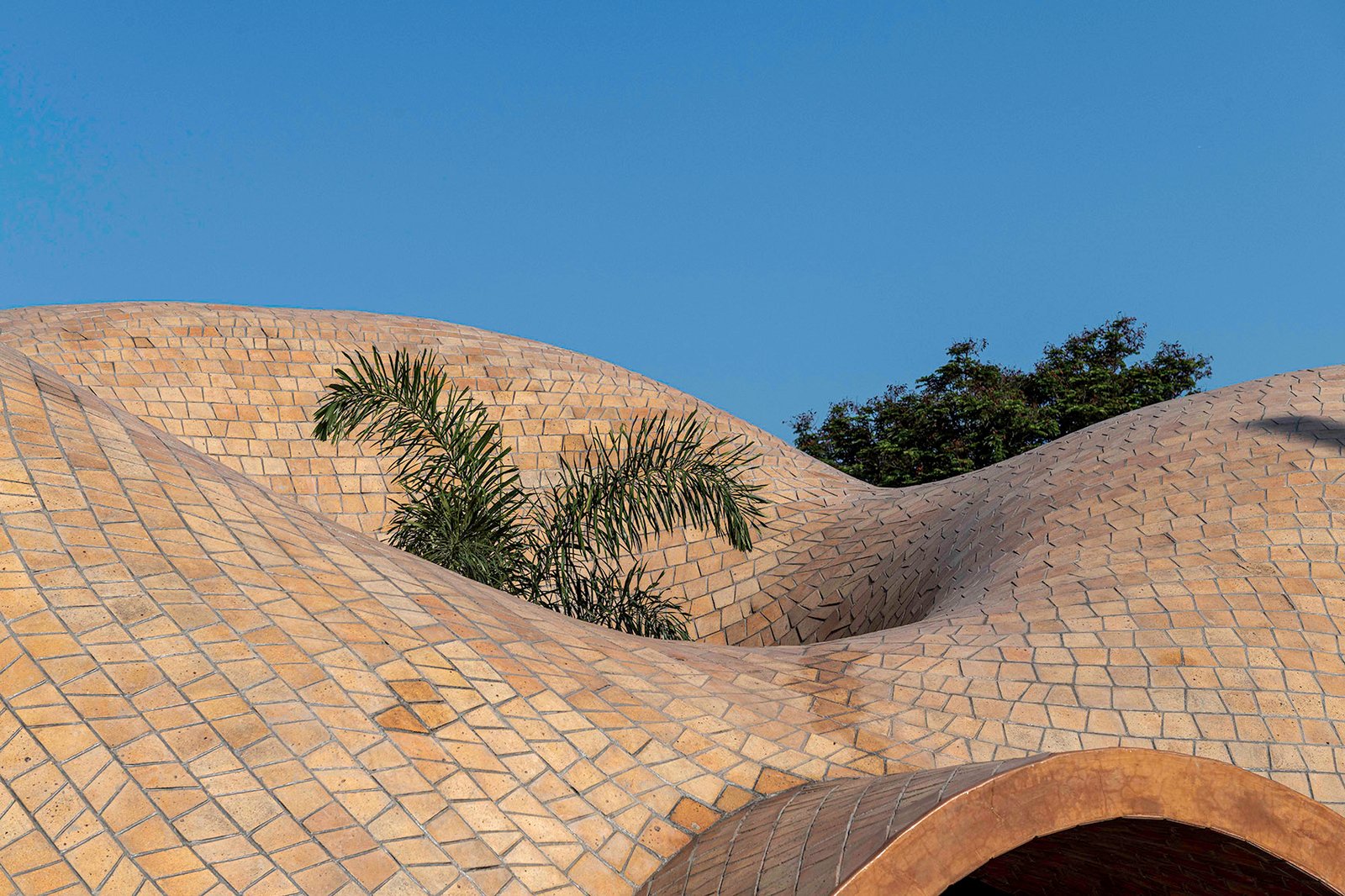
展亭的轮廓线条温柔地隆起,又轻柔地俯冲下来,如和谐的水波一般营造出一种令人回味的宁静氛围,在这里,光线的低语与微风的吟唱一同回荡在拱顶之中,与屋瓦协奏出一曲美妙的乐章。“TARANG”展亭是目前印度最大的赤陶瓦拱顶结构之一。植根于亲生物的设计方法,展亭上升的拱形形态为人们带来了一种令人愉悦的亲密感与熟悉感,由此产生的氛围,简单、深刻而优雅,流畅的室内空间被不断变化的光线与微风所激活。
Gentle upswells. Soft swoops. Harmonic waves that birth an ambience of evocative silence, where the light speaks, the wind sings, and theearthenwareroofing producesmelody. This is “TARANG”, presently one of the largest terracotta tile arch vault structure in India. Its rising arched interiors are pleasantly intimate and familiar, thanks to its form rooted in a biophilic design approach.The resultant atmosphere, profound and simply elegant, is animated by the changing patterns of light and wind.
▼连续的拱形元素,continuous arches© Vinay Panjwani
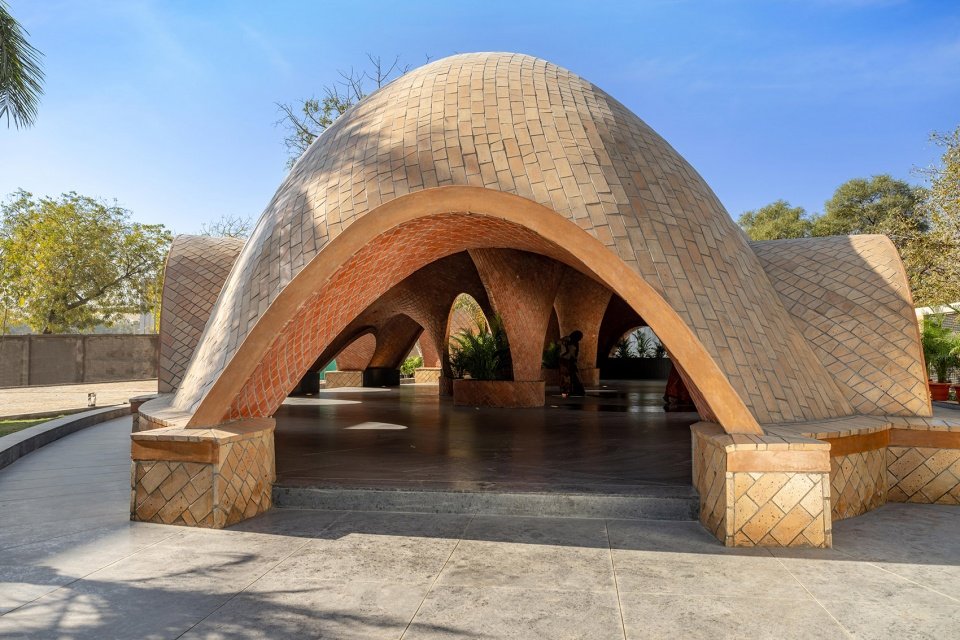

设计
Design Note
起伏的空间形态为观赏者带来了不同的视角。有机的形态与项目的弘伟尺度形成鲜明的对比,自然光线穿过空间的缝隙,掠过没有角落的墙壁,创造出有趣的光影游戏。在这里,结构吞没了空间,起伏变成了墙面,而墙体又转化成围墙。它让人意识到,正是这些空洞的部分和中间裸露的陶瓦串联了整个建筑结构,它引导着人们沿着蜿蜒的形状摇摆,感受着裸露陶瓦散发出自然泥土的气息。它将我们与自然融为一体,仿佛建筑形式并不存在,而是从地球本身的核心诞生出来的造物。
The formed undulations bring a varied Aspect to the viewers eyes. The organic structure contradicts the existing edifice of the project. The light and the shadow from the voids and the in between spaces playfully tease the user, brushing past the cornerless realm of walls. The structure engulfs the space, the undulations become the walls, the walls become the enclosure. It makes one realise that it’s the parts of the voids and the exposed terracotta tilesin between that make the edifice as one. It makes one sway along the meandering shape and smell the natural exposed terracotta tiles. It merges us with nature as if the built form didn’t exist but was born from the core of the earth itself.
▼视频,video© Vinay Panjwani
本项目影片是对人类创造力之美的非凡记录,这座令人过目难忘的精致建筑艺术作品由tHE gRID Architects事务所创作,设计师Snehal和Bhadri巧妙地将细致入微的设计与空间的形式和功能结合在一起,以具像化的方式捕捉了建筑内部空间的动态韵律。影片中的舞者巧妙地暗示出波浪起伏的节奏,用他们的每一个动作彰显出空间的流动和优雅。随着影片的发展,它让观众沉浸在一个不断发展的情感旅程中,以一个真实故事,描绘出一种发自内心又令人信服的对于“联系”的渴望。这部影片背后的创作过程是非常有机的,其初衷旨在以一种深刻的个人叙事视角,来探索人类对“联系”的内在渴望。通过对这一主题的诗意描绘,这部影片精准地表达出人在那一时刻下的深刻情感。
This film is aremarkable documentation of the beauty of human creativity, featuring the impressive shapes that elevate the work of art. tHE gRID Architects – the designers Snehal and Bhadri have deftly blended nuanced design with form and functionality to capture the freedom of movement within the structure. The dancers in the film skilfully embody the rhythm of the undulating swells, encapsulating its fluidity and grace with their every move. As the film progresses, it immerses the viewer in an ever-evolving emotional journey, offering a tangible story of an introverted desire for connection that is both visceral and compelling.The creative process behind this film was very organic, evolving into a deeply personal narrative that explores the intrinsic human desire for connection. Through its poetic portrayal of this universal theme, the film serves as a poignant portrait of that particular moment in time.
▼顶视图,top view© Vinay Panjwani
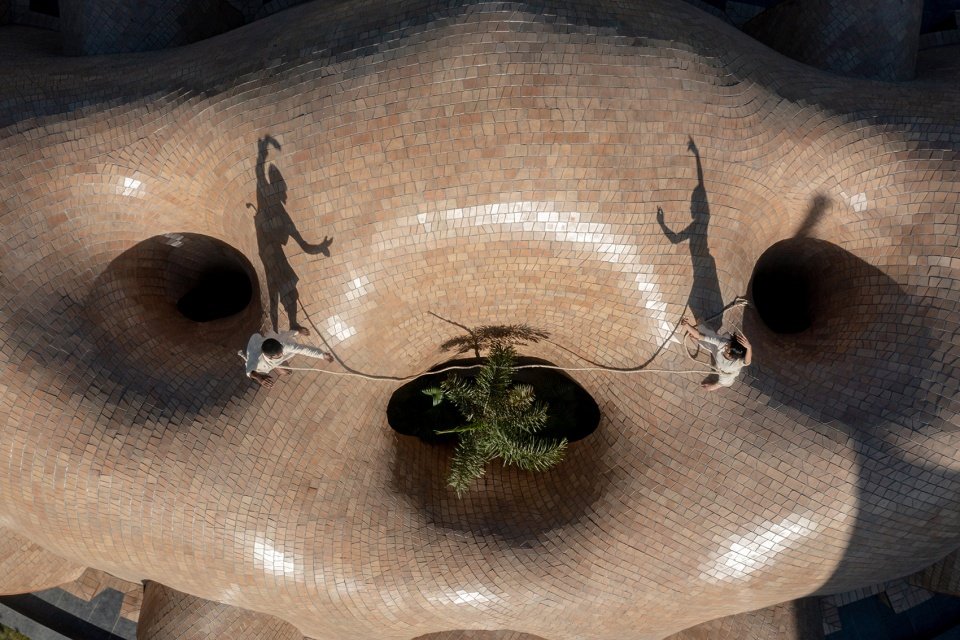
▼两个舞者以绳结暗示出人与人之间的联系,the two dancers use knots to suggest human connection© Vinay Panjwani
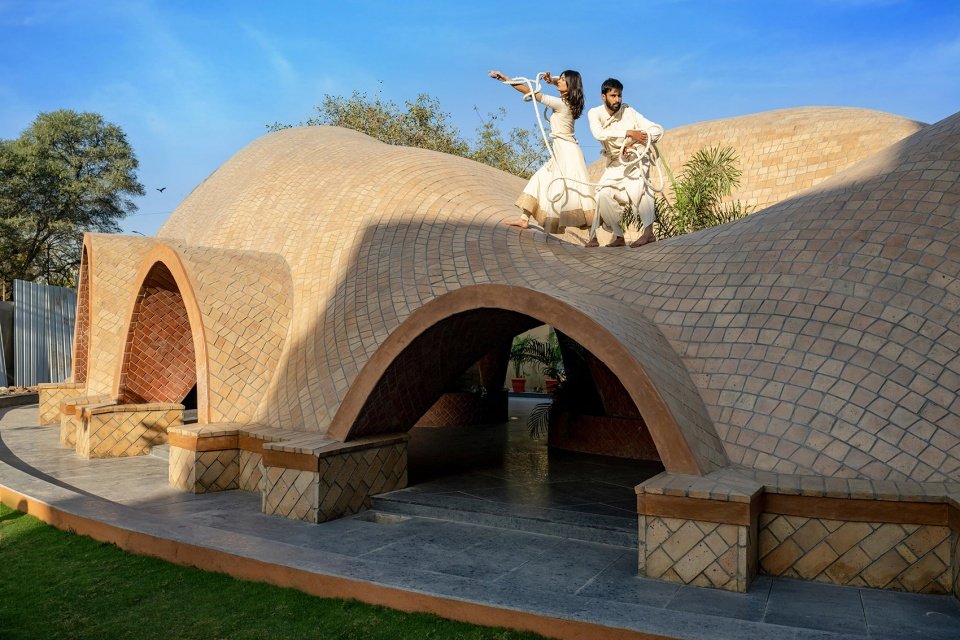
▼人体动态与建筑的自然形态的呼应,the dynamic of the human body echoes the natural form of the building© Vinay Panjwani

▼屋顶视角,roof views© Vinay Panjwani


真正伟大的建筑作品有能力唤起强烈的情感共鸣,这种情感将从建筑师转移到观看者,甚至未来几代人身上,并随着时间的流逝经久不衰。可以说“TARANG”展亭是一个建筑的奇迹,在这里,陶土成为了情感传递的介质,而光和影的相互作用则为室内注入了活力,创造出真正独特的漫射光。
Truly great works of architecture have the power to evoke strong emotions and transfer them from the architect to the visitors who experience them over time and across generations. Within these architectural marvels, the transfer of feeling occurs through the terracotta material itself, while the interplay of light and shadow animates the interiors, creating pockets of diffused light that are truly unique.
▼室内舞蹈场景,dance performance in the pavilion© Vinay Panjwani

▼舞姿表达了人对联系的渴望,the dancing feature expresses a desire for connection© Vinay Panjwani


值得注意的是,即使是恶劣的气候也没有削弱这些结构内部体量激发出的情绪。相反,它们进一步增强了人们对于自然的赞叹与敬畏之心,将人们与过去和现在联系起来,同时营造出一种时间凝固的永恒之美。这座建筑是印度传统文化的完美体现,其设计理念旨在平衡空间与自然之间的关系,为人们创造出一处宁静平和的冥想空间,同时以结构本身彰显出一种显明的力量美感。
Remarkably, even harsh climates fail to diminish the mood of the volumes within these structures. Instead, they continue to inspire awe and wonder, connecting people to the past and the present while imparting a sense of timelessness that endures. The structure is a perfect example of traditional opulence, embodying a design philosophy that seeks to elevate and dignify space and nature in equal measure. It is a meditative structure that fosters a sense of calm and contemplation, where the walls themselves exude a palpable sense of power.
▼流动空间,flowing interior space© Vinay Panjwani


阳光和阴影在空间中的相互作用令人着迷,为陶瓦砖的简单性注入了一种真正非凡的品质。事实上,建筑本身就是成品,原始的材料因空间而升华,超越了自身固有的属性。创作者的出发点分为三个方面,分别为:审美、伦理和神圣。他们试图创造出一个不仅看起来漂亮,而且能够反映他们的价值观和信仰的建筑结构。最终他们以一组光束,创造出无尽的惊喜与美丽的光影,使所有看到它的人都能够产生出情感的共鸣。
The interplay of sunlight and shadow within the space is nothing short of mesmerizing, imbuing the simplicity of the terracotta brick tiles/ bricks with a quality that is truly remarkable. Indeed, the structure itself is the finished product, where the rawness of the materials is transformed into something sublime and transcendent. The designers’ motivationfor the project is threefold: aesthetic, ethical, and divine. They sought to create a structure that not only looks beautiful but also reflects their values and beliefs. Their efforts produced a set of light beams that offer an element of surprise and beautiful reflections, making the structure that resonates with all who behold it.
▼结构与光影,light and shadow of the structure© Vinay Panjwani
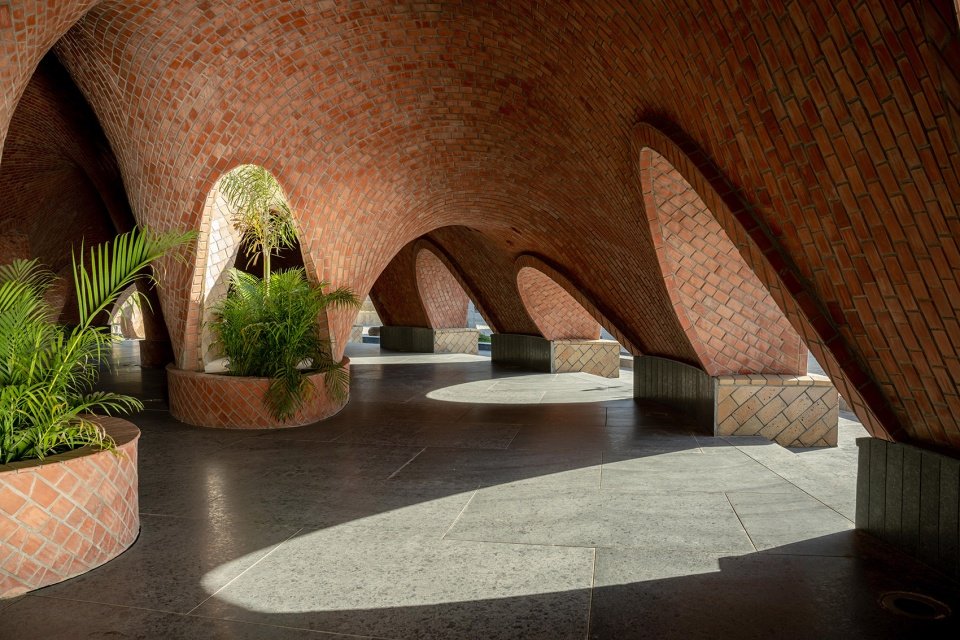
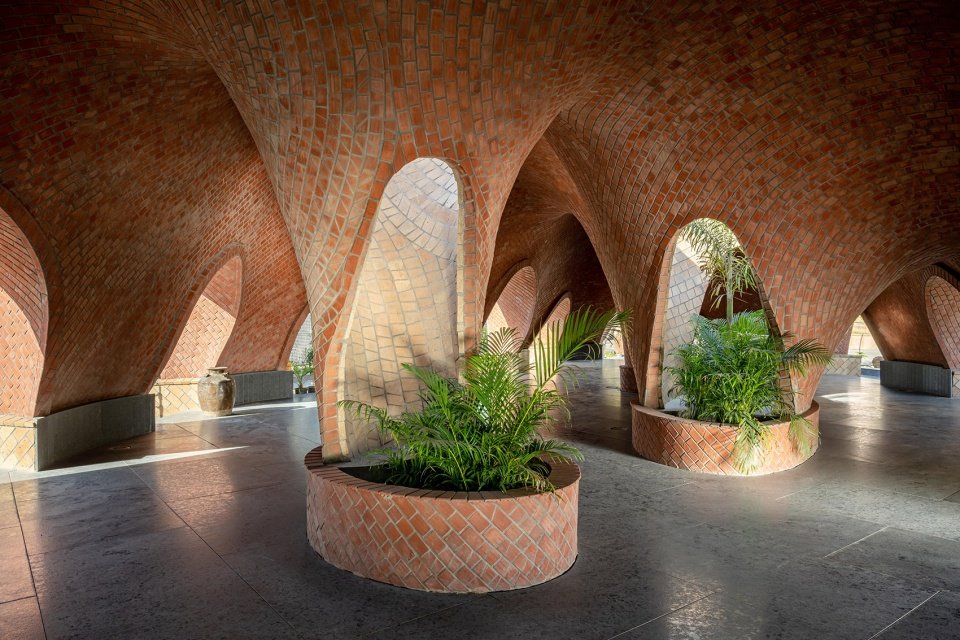
空间的设计旨在从自然中汲取灵感,并模仿出自然造物的有机形态。在整个设计阶段,内部空间仍然是一个谜,建筑师们无法不确定人们在这些空间中的行为方式,也无法为其制定最终的空间尺寸。只用通过日常观察光线的变化和太阳的运动,内部空间的韵律才得以彰显,呈现出和谐且充满活力的环境氛围。直觉与深刻的渴望推动了项目设计的过程,建筑师希望通过探寻空间与自然的需求来为这个建筑作品赋予真实的意义与尊严。因此,内部空间的设计应运而生,与整体建筑的设计完美互补。
The design of the space was intended to draw inspiration from nature and emulate its organic shapes. Throughout the design phase, the interior spaces remained an enigma, and it was uncertain how they would behave or what their dimensions would ultimately be.It was only through daily observation of the shifting light and sun movements that we discovered how the space would shape-shift, creating a harmoniousand dynamic surrounding. The design process was driven by intuition and a deep desire to understand what the space and nature needed to truly elevate and dignify the structure. As a result, the interior spaces just fell into place, perfectly complementing the overall design.
▼建筑与植物自然融合,natural integration between the plant and the pavilion© Vinay Panjwani

▼建筑完全由石材与手工陶瓦建造,the pavilion was built entirely of stone and hand-made terracotta© Photographix India

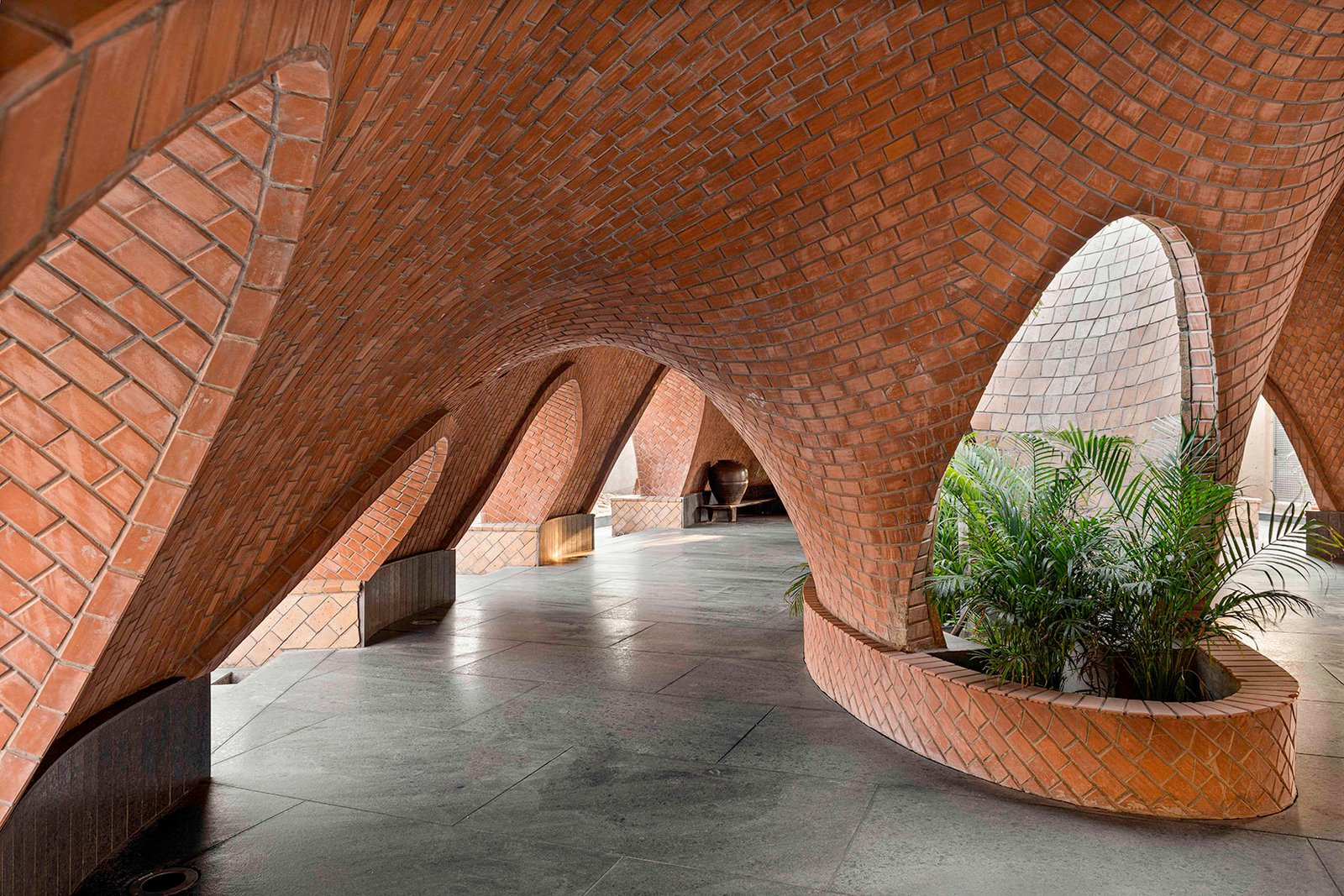
项目的独特之处在于,在一天的不同时间中,不同的空间将为人们带来不同的感受与心情。然而这些空间都具有同一种统一的品质,即,宁静、平和、引人沉思,让游客完全沉浸在空间的美好与能量中。本项目汇集了一批技艺精湛的工匠,他们对曾经在印度广泛使用的传统建筑技术有着深入的了解。这些工匠在材料、工具和技术方面积累了丰富的经验,并反映在他们熟练的工艺上。
One of the great joys of experiencing this structure is the ability to enjoy it in different spaces, during different times of the day with different moods and intentions. The space has a tranquil quality that encourages peaceful contemplation, allowing visitors to fully immerse themselves in its beauty and energy. Skilled artisans who possess in-depth knowledge of the traditional building techniques that were once widely used across India have emerged. These craftspeople have accumulated a wealth of wisdom pertaining to materials, tools, and techniques, which is reflected in their skilled craftsmanship.
▼灯光设计,lighting design© Vinay Panjwani
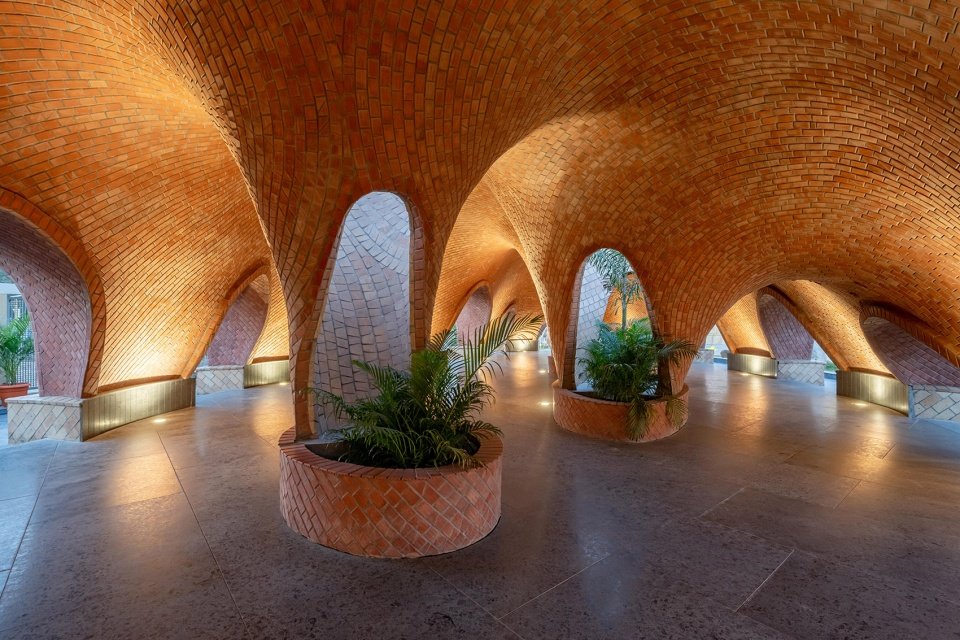

▼室内夜景,night views of interior© Vinay Panjwani


该项目所体现的价值观价值围绕着三个关键原则:对地球母亲的深切尊重和对可持续性的需求;对传统工艺的传承与对手工价值的肯定;对历史的敬畏与对文化遗产的保护。TARANG展亭为建筑领域提供了以人为本与环境友好的设计方向,可以说,这座建筑是社会的宝贵财富,它以富有包容性的设计原则,促进了可持续建筑的发展,以及当地社区参与和艺术文化互动。
The values of the project are centered around three key principles: a deep respect for Mother Earth and the need for sustainability; a genuine appreciation for the art of craftsmanship and the value of working with one’s hands; and a profound reverence for history and the preservation of cultural heritage. Tarang’s design offers several benefits that are both people-centric and environmentally considerate. The building serves as a valuable asset to society, meeting the principles of inclusive design and promoting sustainability, fostering community engagement and interaction for art and culture.
▼室外夜景,night views of exterior© Vinay Panjwani

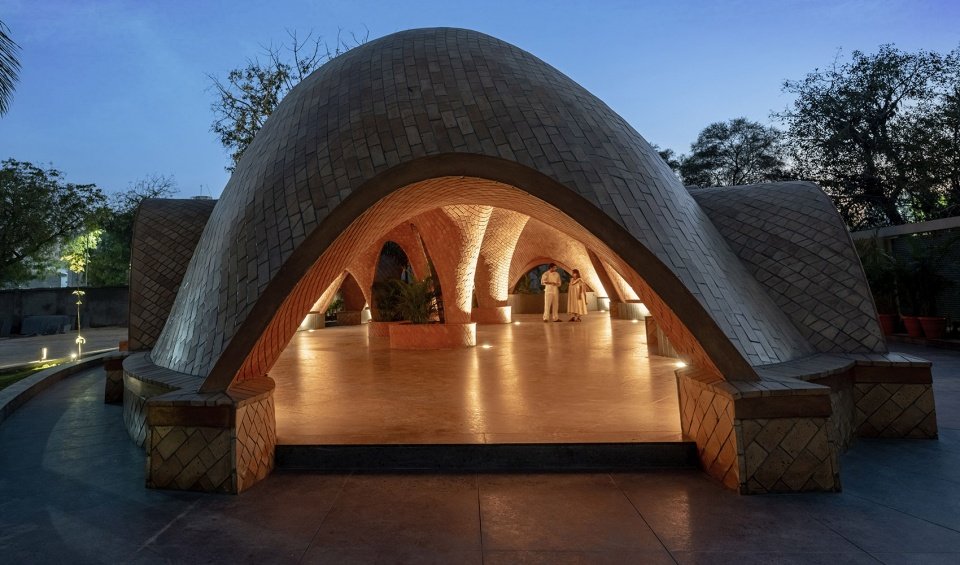
Project:TARANG (means waves in Hindi language) fluid like water
Area: 75’ X 40’ approximately 3000 sq ft
Location: Ahmedabad, India
Design firm: tHE gRID Architects
Designers: Snehal Suthar and Bhadri Suthar
Photo credits: Vinay Panjwani & Photographix India
Film credits: Vinay Panjwani
Completion date: 2023
Technical Guidance and structural form finding by – “Sankalan.”
A Centre of Alternative Learning
Constructed by Artisans of – “So Hath-100 Hands” Foundation for Building Artisans, Bhuj, Gujarat.
Tarang film: UNLISTED
More:tHE gRID Architects更多关于他们: tHE gRID Architectson gooood
